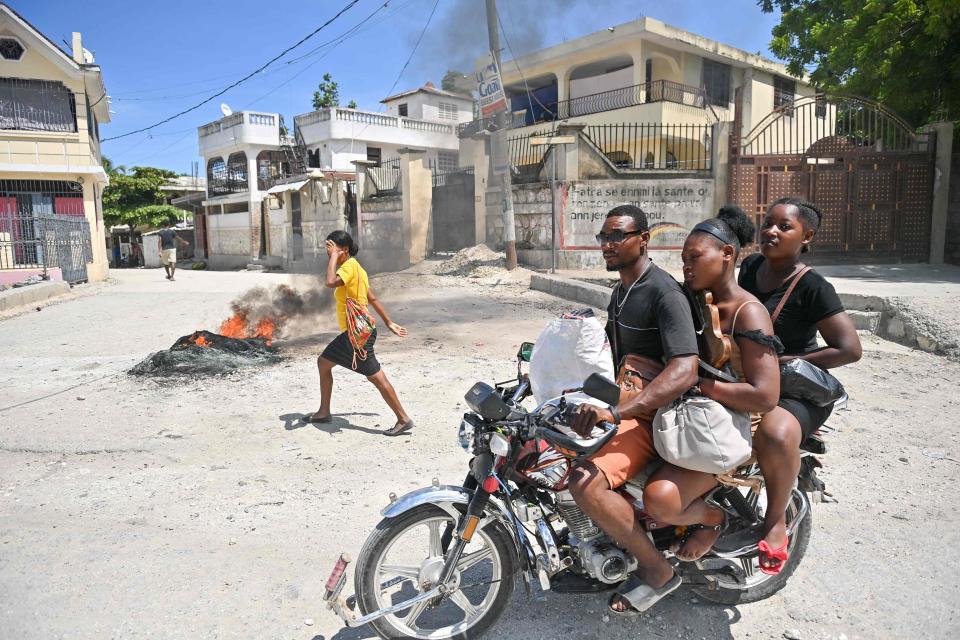United States can afford to save lives not just in Ukraine, but also in Haiti
A story recently aired on "60 Minutes" about how U.S. aid is used to defeat Russia. It was evident from the story that Ukrainians are grateful for U.S. support. Can’t blame them. A whopping $112 billion from taxpayers has gone to Ukraine.
“This is a great deal for America,” Sen. Lindsey Graham commented in the story. “We reduced the combat power of the Russian army by 50%, and not one of us has died in that endeavor.” Graham was in Ukraine with Sen. Richard Blumenthal and Sen. Elizabeth Warren to “monitor” the U.S. investment.
But not everyone in Congress supports aid to Ukraine. The additional $24 billion requested by the White House became tied up in the government shutdown debacle. “We cannot under any circumstances allow America’s support for Ukraine to be interrupted,” protested President Joe Biden.
Not just hardliners in Congress oppose funding Ukraine. A majority of Americans now oppose funding the war. Can’t blame them either. The $112 billion over the 168 million U.S. taxpayers in 2023 equals $700 per taxpayer. Expensive. But saving lives is still the right thing to do.
So what about saving the lives of Haitians perishing from gang violence?
Earlier this year CNN aired a story about gang violence in Port-au-Prince. The video by Nick Walsh, who reports for CNN International, shows him inside an armored car with members of the Haitian police. As the video advanced, sounds of rapid and powerful gunfire erupted. The Haitian police were firing their heavy-caliber rifles seemingly at nothing but dilapidated buildings. It was unclear who their target was, yet the video informed the viewer that gang members hiding on the other side of the street were the target.
The camera zoomed through a tiny window on the armored car to bring to view littered streets, bullet-ridden shacks, and men, women and children running from the gunfire. Then another frame revealed women with infants in their arms, standing in exposed, yet crowded space, to seek shelter from gangs, who according to the CNN video, would “shoot even children with impunity.”
I saw children seated on bare concrete, blanketed by flies, filling their stomachs from empty Styrofoam take-out containers. “They burned my house. Down here children are starving,” a caption translated a statement in Creole by a woman with an infant in her arms. Then a child's voice emerged and the caption read: “My mother and my father have died,” adding more salt to Haiti’s open colonial wounds.

According to Human Rights Watch, more than 1,000 Haitians are likely to have been killed in massacres since 2018. According to NPR, more than 100,000 people have fled their homes.
Haiti’s struggle stems from the 1492 “discovery” of an island in the Caribbean by Christopher Columbus. The island belonged to the Taíno people, and still, Columbus named the island Hispaniola. Then Spain ceded Hispaniola to France in 1697, and its western side became Saint-Domingue. Then enslaved Africans were shipped across the Atlantic to labor on sugar and coffee plantations in Saint-Domingue. Enslavers in Saint-Domingue had trade relations with enslavers in the United States.
Saint-Domingue declared its independence to become Haiti in 1804. Yet France refused to accept defeat and forced Haiti to pay reparations for its freedom. Some estimate the reparations to be as much as 30 billion in today’s dollars.
Former French President François Hollande admitted that the French colonial legacy in Haiti to be “a moral debt.” Yet France still refuses to repay the stolen funds, and Haiti, a predominantly Black nation, remains the poorest nation in the Western Hemisphere.
Is pressuring France to amend its legacy of colonialism in Haiti, curbing gang violence and strengthening Haiti’s infrastructure of U.S. national interest? What if the interventions lowered the number of migrants in the U.S. Southern border? Would America’s taxpayers be OK? Can’t afford it? Let’s do some math.
The United States has spent $5.6 billion in aid to Haiti since the 2010 earthquake that took 200,000 lives. The $5.6 billion from the 141 million Americans who, according to the IRS, filed taxes in 2010 equals $40 per taxpayer.
After another earthquake struck Haiti in 2021, about $2 billion was requested for recovery and rebuilding. If the United States had provided the entire $2 billion, dividing the amount by the 158 million U.S. taxpayers who according to the Tax Foundation, filed returns in 2020 equals $13 per taxpayer.
Now let’s consider what the United States has spent in Ukraine. The $700 per taxpayer is 14 times the aid to help Haiti recover from the earthquakes.
To say we can’t afford helping in Haiti would be a lie.
The United States can afford meeting its pledge of $100 million toward the Kenya-led peacekeeping mission in Haiti. That’s less than $1 per taxpayer.
The United States can afford the $210 million requested by UNICEF to “meet the humanitarian needs of Haitian children and their families in 2023.” That’s $1.25 per taxpayer.
Giving more to save priceless lives for less than the price of a burger. Not doing so? Cheap.

Walter Suza of Ames, Iowa, writes frequently on the intersections of spirituality, anti-racism and social justice. He can be contacted at wsuza2020@gmail.com.
This article originally appeared on Des Moines Register: US aid is saving lives in Ukraine, but why should we stop there?

